Glare from surgical lights can reflect off your monitor, hiding critical details. This distraction can compromise precision, but the right screen finish provides the visual clarity and comfort you need.
The main difference is how they handle light. Glossy screens offer sharper, more vibrant images but create mirror-like reflections. Matte screens use an anti-glare surface to diffuse reflections, making them easier to view under bright lights, though with a slight trade-off in crispness.
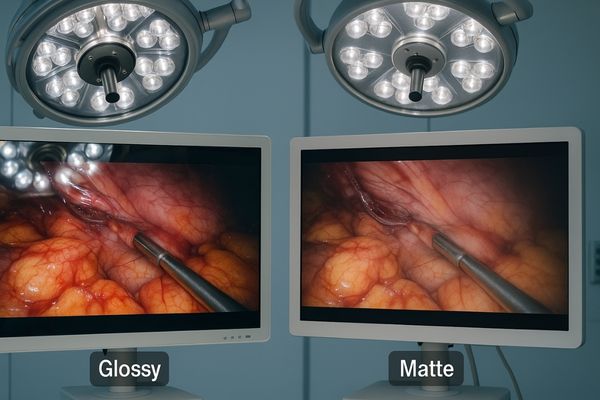
In my work, I have seen how the choice between a glossy and a matte screen1 can significantly impact a surgeon’s experience. This is not just a matter of preference. It is about how the monitor performs in the demanding environment of the operating room. A screen’s surface directly influences image clarity2, reflections, and even surgeon fatigue3. Understanding this difference is essential for selecting a display that enhances, rather than hinders, surgical performance. This article will explain the key characteristics of each screen type and help you determine which is best suited for your specific clinical needs.
Why do glossy screens offer sharper images in surgical displays?
You need to see the finest tissue details with maximum clarity. A standard screen might make subtle color variations look washed out, but a glossy finish brings the image to life.
Glossy screens have a smooth, un-etched surface. This allows light from the display panel to travel directly to the viewer’s eyes without any diffusion. This direct path results in deeper blacks, more vibrant colors, and higher perceived sharpness and contrast.
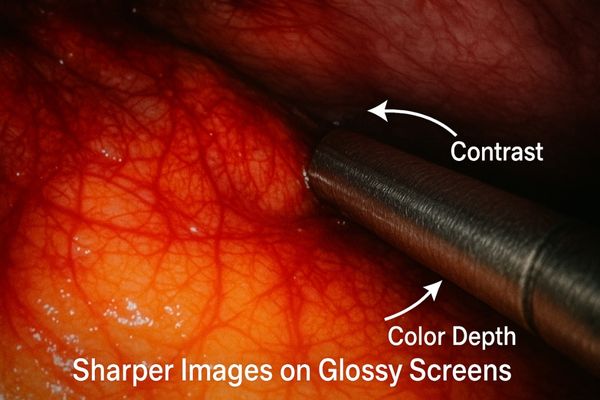
The sharpness of a glossy screen4 comes from its perfectly smooth surface. The screen acts as a clear window to the pixels behind it. Light from the liquid crystal display (LCD) panel passes through this clear layer without being scattered. This preserves the integrity of the image. The result is that colors appear more saturated and vibrant, and blacks look deeper and more absolute. This increased contrast ratio5 can be very important in surgery. It helps surgeons distinguish between subtle shades of red, which can indicate differences between healthy and ischemic tissue. For large-format displays where an immersive view is critical, such as our MS550P 4K monitor, a glossy finish can provide a stunningly vivid and lifelike image. This perceived clarity and color pop can enhance a surgeon’s ability to interpret visual information quickly and confidently during a procedure.
How does ambient light affect glossy and matte screens differently in an OR?
Bright overhead surgical lights are creating intense glare on your monitor. This reflection can completely obscure the surgical image, but the screen’s finish determines how it handles this challenge.
Glossy screens act like a mirror, creating sharp, specular reflections of light sources. In contrast, matte screens have a textured surface that scatters ambient light, diffusing bright reflections into a softer, less distracting haze, making them easier to view under direct lighting.
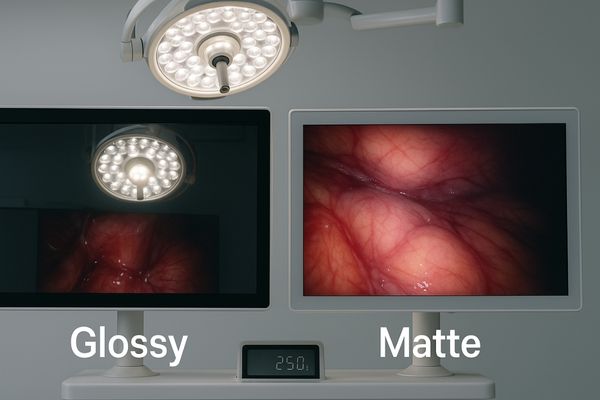
An operating room is one of the most challenging environments for any display due to multiple, high-intensity light sources. Glossy and matte screen6s manage these lights in completely different ways. A glossy screen has a smooth surface that causes specular reflection. This means a bright light source will create a clear, mirror-like image on the screen. If a surgical light is positioned incorrectly, its reflection can easily block the view of the anatomy underneath. A matte screen, however, has a surface that is microscopically rough or etched. This texture creates diffuse reflection. When light hits this surface, it scatters in many directions instead of reflecting directly back at the viewer. This turns a sharp, distracting glare into a soft, blurry glow that is much less likely to obscure the primary surgical image. Monitors like our large-format MS430PC are often used in complex setups where lighting is variable, making effective glare management7 a critical performance feature.
Screen Performance Under OR Lighting
| Lighting Condition | Glossy Screen | Matte Screen |
|---|---|---|
| Direct Overhead Light | Strong, mirror-like reflections | Diffused, soft haze; less distracting |
| Low, Controlled Light | Excellent contrast and color | Very good, with minimal diffusion |
| Off-Angle Viewing | Reflections are highly visible | Reflections are diffused from all angles |
Are matte screens always better for reducing reflections during surgery?
You might assume a matte screen is the only solution for operating room glare. This choice, however, can come with a subtle trade-off in absolute image crispness that is important to consider.
Yes, matte screens are almost always better for reducing the intensity of direct, mirror-like reflections. However, the anti-glare etching can introduce a subtle haze or sparkle, slightly reducing the "pop" and sharpness of the image compared to a glossy screen.
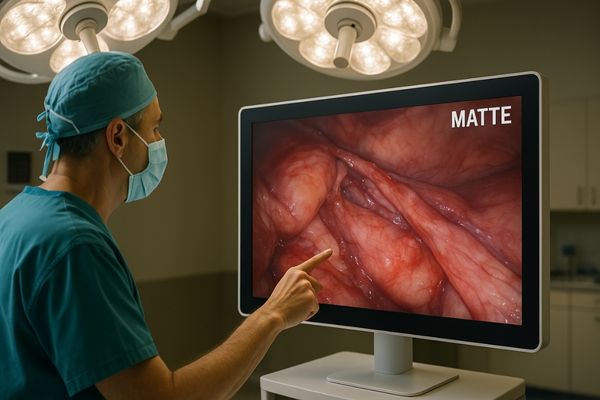
For the specific task of reducing glare, matte screens are superior. The anti-glare (AG) surface8 is engineered to do exactly that. It effectively breaks up specular highlights from surgical lamps and other light sources. This makes the screen usable in a much wider range of lighting conditions. However, this benefit comes with a small compromise. The same microscopic texture that scatters external light can also slightly diffuse the light emitted from the monitor’s own pixels. This can cause a very subtle softening of the image. The finest details might not appear as tack-sharp as they would on a glossy display9. For most surgical applications, this effect is negligible and far outweighed by the benefit of glare reduction. However, in specialties that demand the absolute highest level of detail, some surgeons may prefer a glossy screen and will instead modify the OR environment to control reflections. A versatile monitor like the MS270P with a high-quality matte finish often represents the best balance for general surgery.
Do glossy screens increase surgeon fatigue over long procedures?
After hours of surgery, your eyes feel strained and tired. This mental and physical drain can reduce your focus and precision when it matters most, and the screen surface can be a key factor.
Yes, glossy screens can significantly increase surgeon fatigue if reflections are not managed. The surgeon’s eyes and brain must constantly work to ignore distracting reflections, leading to increased cognitive load and eye strain over the course of a long procedure.
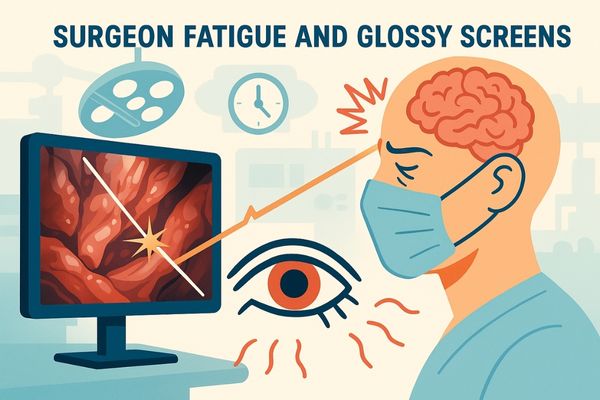
Surgeon fatigue is a serious issue, and display ergonomics10 play a large role. A glossy screen in a typical OR environment presents the brain with two competing images: the primary surgical video feed and the reflections from the room. Your brain must actively filter out the reflections to focus on the important clinical information. This constant filtering process is mentally taxing. Furthermore, your eyes may involuntarily shift focus between the surgical image, which appears at a certain depth, and the reflections on the physical surface of the screen. This continuous refocusing strains the ciliary muscles in the eyes. Over a multi-hour surgery, this combined mental and physical effort leads to fatigue, which can impact concentration and decision-making. Matte screens reduce this load by presenting a single, clear image without distracting reflections. Even for smaller endoscopic monitors like the MS220S, where the surgeon is close to the screen, minimizing these micro-distractions is key to maintaining performance.
How does Reshin choose between glossy and matte finishes for its surgical monitors?
You need a monitor for your OR, but you are not sure which screen finish is right. Making the wrong choice could lead to daily frustration, but a one-size-fits-all approach does not work.
We do not make a single choice; we provide tailored options. Reshin offers both glossy finishes for maximum image vibrancy and advanced matte anti-glare screens for superior reflection control. Our goal is to match the monitor’s characteristics to the specific surgical application.
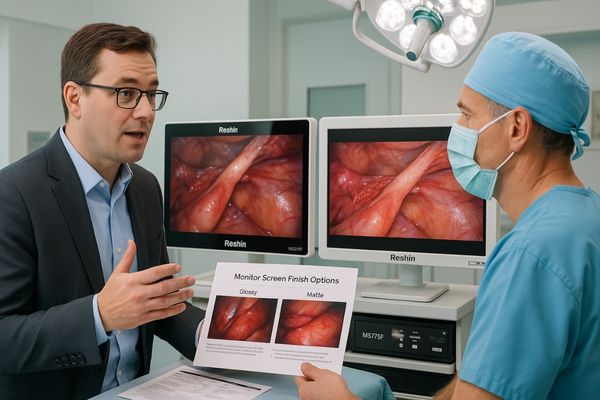
We believe the best monitor is one that is perfectly suited to its environment. There is no universal "best" screen finish, because every surgical specialty and operating room is different. Our approach is consultative. We work with surgeons to understand their specific needs. For procedures where absolute color fidelity11 is the highest priority and the OR has highly controlled, indirect lighting, a glossy screen might be the optimal choice. However, for the vast majority of modern, multi-purpose operating rooms, we typically recommend a matte finish. Our anti-glare technology12 is designed to provide excellent diffusion with minimal impact on sharpness. For example, our MS275P 4K monitor uses a bonded anti-glare glass that preserves image clarity while effectively eliminating distracting reflections. By offering both options and providing expert guidance, we ensure that surgeons get a display that enhances their workflow, improves their comfort, and supports the best possible patient outcomes.
Conclusion
Glossy screens provide vibrant images but can cause distracting glare. Matte screens excel at controlling reflections, which is crucial in a bright OR. The ideal choice balances image clarity with environmental lighting. For surgical displays optimized for glare control and clarity, contact Reshin at martin@reshinmonitors.com.
-
Explore this resource to understand how screen types affect surgical performance and surgeon comfort, crucial for optimal clinical outcomes. ↩
-
This link will provide insights into the importance of image clarity in surgical settings, helping you make informed decisions about monitor selection. ↩
-
Discover the various factors that lead to surgeon fatigue, including monitor choice, to enhance surgical efficiency and well-being. ↩
-
Explore how glossy screens enhance image quality and color vibrancy, crucial for applications like surgery. ↩
-
Understanding contrast ratio is key to appreciating how it impacts visual clarity and detail in critical settings. ↩
-
Exploring the benefits of matte screens can help in selecting the right display technology for surgical applications. ↩
-
Understanding glare management is crucial for optimizing visibility in surgical environments, ensuring better outcomes. ↩
-
Understanding the technology behind anti-glare surfaces can help you choose the right monitor for your needs. ↩
-
Exploring the benefits of glossy displays can inform your decision on monitor types for specific applications. ↩
-
Display ergonomics can significantly enhance a surgeon’s focus and efficiency. Discover more about its impact on surgical practices. ↩
-
Learn why color fidelity is crucial in surgical settings to ensure accurate visual representation and better patient outcomes. ↩
-
Explore this link to understand how anti-glare technology enhances display quality and reduces distractions in surgical environments. ↩

